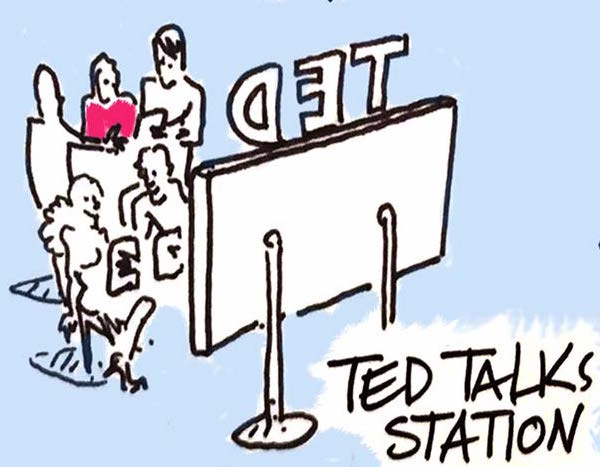When a customer asks us to design an event which we feel requires an element of Innovation from participants, we sometimes use our Ted Talk Module.
Each team is given a different Ted Talk to watch and analyze using a set of guiding questions. Each team is then asked to incorporate the relevant learning and thinking they’ve just been exposed to into their next module, which is typically a first pass toward the design of the overall solution.
Bringing outside ideas in really sparks innovation and gives teams a creative boost. Because each team has a different Ted Talk, it allows a broad pollination of new ideas into the design process adding additional acceleration that would not have been possible if each group had watched all Ted Talks. Each team absorbs what they think is most applicable to their problem, culture, and landscape and then the participants as a whole get to hear how each Ted Talk influenced a team’s approach—accelerating learning.
The 5 TedTalks we love because of their power to inspire innovative thinking are:
Alejandro Aravena
When asked to build housing for 100 families in Chile ten years ago, Alejandro Aravena looked to an unusual inspiration: the wisdom of favelas and slums. Rather than building a large building with small units, he built flexible half-homes that each family could expand on. It was a complex problem, but with a simple solution — one that he arrived at by working with the families themselves. With a chalkboard and beautiful images of his designs, Aravena walks us through three projects where clever rethinking led to beautiful design with great benefit.
Why we Like It
This is a great example of innovation focussed on the customer’s real needs, desires, and constraints. It inspires us to step-back and look at an entire issue and determine if there are Bright Spots that can be used to fast-track a design. Are there any existing and proven ways to allow us to move forward faster and with confidence? We like this as it gives participants new insights into innovating from existing proven solutions.
Joi Ito
“Remember before the internet?” asks Joi Ito. “Remember when people used to try to predict the future?” In this engaging talk, the head of the MIT Media Lab skips the future predictions and instead shares a new approach to creating in the moment: building quickly and improving constantly, without waiting for permission or for proof that you have the right idea. This kind of bottom-up innovation is seen in the most fascinating, futuristic projects emerging today, and it starts, he says, with being open and alert to what’s going on around you right now. Don’t be a futurist, he suggests: be a now-ist.
Why we Like It
We like this talk because Ito serves up a very thought provoking set of principles for innovation in today’s connected world. He brings a different point of view to mainstream theory around innovation, and his story on the nuclear disaster in Japan serves as a beacon that innovation can be brightest when the need is strongest.
Steven Johnson
People often credit their ideas to individual “Eureka!” moments. But Steven Johnson shows how history tells a different story. His fascinating tour takes us from the “liquid networks” of London’s coffee houses to Charles Darwin’s long, slow hunch to today’s high-velocity digital world.
Why we Like It
This talk by Johnson shakes the foundations of those who think that innovation is only a process. After listening to this talk, it is easy to relate to the basic premise that unusual levels of innovation and creativity do have some similarities, but in order to accept this point of view it is necessary to peel back and challenge the premises upon which conventional theory presents innovation. We like this talk because it provokes participants to think about communication, idea sharing, networking, and of course the simple cafe.
Matt Ridley
At TEDGlobal 2010, author Matt Ridley shows how, throughout history, the engine of human progress has been the meeting and mating of ideas to make new ideas. It’s not important how clever individuals are, he says; what really matters is how smart the collective brain is.
Why we Like It
This talk is very close to one of our core beliefs – that the people inside an organization are the ones in the best position to solve complex problems. The key is to clear the path for them to collaborate together. We like this talk, because the team that watches it together typically bonds together – gaining a sense of “we can do this together”, creating a tighter bond whilst also breaking inhibitions.
Tim Brown
At the 2008 Serious Play conference, Tim Brown talks about the importance of playfulness when coming up with creative solutions – be they new products or service, or problem solving. Brown espouses the benefits of both divergent and convergent thinking. Trust is essential to creating an environment for playfulness – trust to play, trust to be creative – and that the behaviors we exhibited as children should be encouraged for creativity today – explore many ideas, build with your hands, and role-play to find empathy and understand different points of view.
Why we Like It
This talk addresses a key barrier to innovation— the fear of failure and the judgement of others. We like this talk because it inspires participants to realize that they have the freedom to fail, explore, and play. This freedom allows teams to push ideas to the limit, which is a key part of the Share and Explore stage of an event. We also like the role play (min 19:30) and the point-of-view (min 21:50). This also supports why we build in 3D modeling as a module in some of our designs. We understand the power of playfulness.



